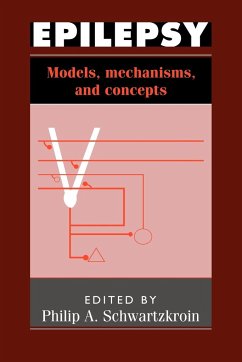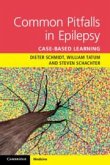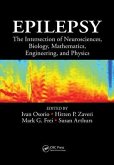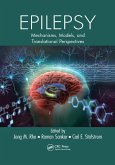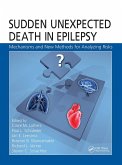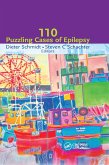Philip A. Schwartzkroin (ed.)Models, Mechanisms and Concepts
Epilepsy
Models, Mechanisms and Concepts
Herausgeber: Schwartzkroin, Philip A.
Philip A. Schwartzkroin (ed.)Models, Mechanisms and Concepts
Epilepsy
Models, Mechanisms and Concepts
Herausgeber: Schwartzkroin, Philip A.
- Broschiertes Buch
- Merkliste
- Auf die Merkliste
- Bewerten Bewerten
- Teilen
- Produkt teilen
- Produkterinnerung
- Produkterinnerung
This book considers a number of major concepts and models in epilepsy research, to advance understanding of the basic mechanisms involved.
Andere Kunden interessierten sich auch für
![Common Pitfalls in Epilepsy Common Pitfalls in Epilepsy]() Dieter SchmidtCommon Pitfalls in Epilepsy68,99 €
Dieter SchmidtCommon Pitfalls in Epilepsy68,99 €![Epilepsy Epilepsy]() Epilepsy126,99 €
Epilepsy126,99 €![Epilepsy Epilepsy]() Epilepsy80,99 €
Epilepsy80,99 €![Sudden Unexpected Death in Epilepsy Sudden Unexpected Death in Epilepsy]() Sudden Unexpected Death in Epilepsy97,99 €
Sudden Unexpected Death in Epilepsy97,99 €![One Hundred Case Studies in Epilepsy One Hundred Case Studies in Epilepsy]() One Hundred Case Studies in Epilepsy77,99 €
One Hundred Case Studies in Epilepsy77,99 €![My Life with Epilepsy My Life with Epilepsy]() Mari C SchuhMy Life with Epilepsy10,99 €
Mari C SchuhMy Life with Epilepsy10,99 €![Epilepsy Board Quick Review Epilepsy Board Quick Review]() Jerome EngelEpilepsy Board Quick Review47,99 €
Jerome EngelEpilepsy Board Quick Review47,99 €-
-
-
This book considers a number of major concepts and models in epilepsy research, to advance understanding of the basic mechanisms involved.
Hinweis: Dieser Artikel kann nur an eine deutsche Lieferadresse ausgeliefert werden.
Hinweis: Dieser Artikel kann nur an eine deutsche Lieferadresse ausgeliefert werden.
Produktdetails
- Produktdetails
- Verlag: Cambridge University Press
- Seitenzahl: 560
- Erscheinungstermin: 26. Dezember 2006
- Englisch
- Abmessung: 229mm x 152mm x 33mm
- Gewicht: 898g
- ISBN-13: 9780521033503
- ISBN-10: 0521033500
- Artikelnr.: 22583977
- Herstellerkennzeichnung
- Libri GmbH
- Europaallee 1
- 36244 Bad Hersfeld
- gpsr@libri.de
- Verlag: Cambridge University Press
- Seitenzahl: 560
- Erscheinungstermin: 26. Dezember 2006
- Englisch
- Abmessung: 229mm x 152mm x 33mm
- Gewicht: 898g
- ISBN-13: 9780521033503
- ISBN-10: 0521033500
- Artikelnr.: 22583977
- Herstellerkennzeichnung
- Libri GmbH
- Europaallee 1
- 36244 Bad Hersfeld
- gpsr@libri.de
List of contributors; General introduction Philip A. Schwartzkroin; Part I.
Chronic Models in Intact Animals - Concepts and Questions: Introduction; 1.
The kindling model of epilepsy James O. McNamara, Douglas W. Bonhaus and
Cheolsu Shin; 2. Focal trigger zones and pathways of propagation in seizure
generation Karen Gale; 3. Genetic models of the epilepsies Phillip C. Jobe,
Pravin K. Mishra, Nandor Ludvig and John W. Dailey; 4. Noradrenergic
modulation of excitability: transplantation approaches to epilepsy research
Olle Lindvall; 5. Sensitivity of the immature central nervous system to
epileptogenic stimuli Solomon L. Moshé, Patric K. Stanton and Ellen F.
Sperber; Part II. Features of the Epileptogenic Brain: Introduction; 6.
Neurophysiological studies of alterations in seizure susceptibility during
brain development John. W. Swann, Karen L. Smith, Robert J. Brady and
Martha G. Pierson; 7. Electrophysiology and pharmacology of human neocortex
and hippocampus in vitro Massimo Avoli; 8. Cell death, plasticity and
epilepsy: insights provided by experimental models of hippocampal sclerosis
JoAnn E. Franck; 9. Sprouting as an underlying cause of hyperexcitability
in experimental models and in the human epileptic temporal lobe Thomas P.
Sutula; 10. Rapidly recurring seizures and status epilepticus: ictal
density as a factor in epileptogenesis Eric W. Lothman, Janet L. Stringer
and Edward H. Bertram; Part III. 'Normal' Brain Mechanisms That Support
Epileptiform Activities: Introduction; 11. Brain slice models for the study
of seizures and interictal spikes Wilkie A. Wilson and Andrew Bragdon; 12.
Generation of epileptiform discharge by local circuits of neocortex Barry
W. Connors and Yael Amitai; 13. Study of GABAergic inhibition and GABAA
receptors in experimental epilepsy Robert K. S. Wong and Richard Miles; 14.
High potassium-induced synchronous bursts and electrographic seizures
Christopher J. McBain, Stephen F. Traynelis and Raymond Dingledine; 15.
Anti-epileptic effects of organic calcium channel blockers in animal
experiments Erwin-Josef Speckmann and Jörg Walden; Recent advances; Index.
Chronic Models in Intact Animals - Concepts and Questions: Introduction; 1.
The kindling model of epilepsy James O. McNamara, Douglas W. Bonhaus and
Cheolsu Shin; 2. Focal trigger zones and pathways of propagation in seizure
generation Karen Gale; 3. Genetic models of the epilepsies Phillip C. Jobe,
Pravin K. Mishra, Nandor Ludvig and John W. Dailey; 4. Noradrenergic
modulation of excitability: transplantation approaches to epilepsy research
Olle Lindvall; 5. Sensitivity of the immature central nervous system to
epileptogenic stimuli Solomon L. Moshé, Patric K. Stanton and Ellen F.
Sperber; Part II. Features of the Epileptogenic Brain: Introduction; 6.
Neurophysiological studies of alterations in seizure susceptibility during
brain development John. W. Swann, Karen L. Smith, Robert J. Brady and
Martha G. Pierson; 7. Electrophysiology and pharmacology of human neocortex
and hippocampus in vitro Massimo Avoli; 8. Cell death, plasticity and
epilepsy: insights provided by experimental models of hippocampal sclerosis
JoAnn E. Franck; 9. Sprouting as an underlying cause of hyperexcitability
in experimental models and in the human epileptic temporal lobe Thomas P.
Sutula; 10. Rapidly recurring seizures and status epilepticus: ictal
density as a factor in epileptogenesis Eric W. Lothman, Janet L. Stringer
and Edward H. Bertram; Part III. 'Normal' Brain Mechanisms That Support
Epileptiform Activities: Introduction; 11. Brain slice models for the study
of seizures and interictal spikes Wilkie A. Wilson and Andrew Bragdon; 12.
Generation of epileptiform discharge by local circuits of neocortex Barry
W. Connors and Yael Amitai; 13. Study of GABAergic inhibition and GABAA
receptors in experimental epilepsy Robert K. S. Wong and Richard Miles; 14.
High potassium-induced synchronous bursts and electrographic seizures
Christopher J. McBain, Stephen F. Traynelis and Raymond Dingledine; 15.
Anti-epileptic effects of organic calcium channel blockers in animal
experiments Erwin-Josef Speckmann and Jörg Walden; Recent advances; Index.
List of contributors; General introduction Philip A. Schwartzkroin; Part I.
Chronic Models in Intact Animals - Concepts and Questions: Introduction; 1.
The kindling model of epilepsy James O. McNamara, Douglas W. Bonhaus and
Cheolsu Shin; 2. Focal trigger zones and pathways of propagation in seizure
generation Karen Gale; 3. Genetic models of the epilepsies Phillip C. Jobe,
Pravin K. Mishra, Nandor Ludvig and John W. Dailey; 4. Noradrenergic
modulation of excitability: transplantation approaches to epilepsy research
Olle Lindvall; 5. Sensitivity of the immature central nervous system to
epileptogenic stimuli Solomon L. Moshé, Patric K. Stanton and Ellen F.
Sperber; Part II. Features of the Epileptogenic Brain: Introduction; 6.
Neurophysiological studies of alterations in seizure susceptibility during
brain development John. W. Swann, Karen L. Smith, Robert J. Brady and
Martha G. Pierson; 7. Electrophysiology and pharmacology of human neocortex
and hippocampus in vitro Massimo Avoli; 8. Cell death, plasticity and
epilepsy: insights provided by experimental models of hippocampal sclerosis
JoAnn E. Franck; 9. Sprouting as an underlying cause of hyperexcitability
in experimental models and in the human epileptic temporal lobe Thomas P.
Sutula; 10. Rapidly recurring seizures and status epilepticus: ictal
density as a factor in epileptogenesis Eric W. Lothman, Janet L. Stringer
and Edward H. Bertram; Part III. 'Normal' Brain Mechanisms That Support
Epileptiform Activities: Introduction; 11. Brain slice models for the study
of seizures and interictal spikes Wilkie A. Wilson and Andrew Bragdon; 12.
Generation of epileptiform discharge by local circuits of neocortex Barry
W. Connors and Yael Amitai; 13. Study of GABAergic inhibition and GABAA
receptors in experimental epilepsy Robert K. S. Wong and Richard Miles; 14.
High potassium-induced synchronous bursts and electrographic seizures
Christopher J. McBain, Stephen F. Traynelis and Raymond Dingledine; 15.
Anti-epileptic effects of organic calcium channel blockers in animal
experiments Erwin-Josef Speckmann and Jörg Walden; Recent advances; Index.
Chronic Models in Intact Animals - Concepts and Questions: Introduction; 1.
The kindling model of epilepsy James O. McNamara, Douglas W. Bonhaus and
Cheolsu Shin; 2. Focal trigger zones and pathways of propagation in seizure
generation Karen Gale; 3. Genetic models of the epilepsies Phillip C. Jobe,
Pravin K. Mishra, Nandor Ludvig and John W. Dailey; 4. Noradrenergic
modulation of excitability: transplantation approaches to epilepsy research
Olle Lindvall; 5. Sensitivity of the immature central nervous system to
epileptogenic stimuli Solomon L. Moshé, Patric K. Stanton and Ellen F.
Sperber; Part II. Features of the Epileptogenic Brain: Introduction; 6.
Neurophysiological studies of alterations in seizure susceptibility during
brain development John. W. Swann, Karen L. Smith, Robert J. Brady and
Martha G. Pierson; 7. Electrophysiology and pharmacology of human neocortex
and hippocampus in vitro Massimo Avoli; 8. Cell death, plasticity and
epilepsy: insights provided by experimental models of hippocampal sclerosis
JoAnn E. Franck; 9. Sprouting as an underlying cause of hyperexcitability
in experimental models and in the human epileptic temporal lobe Thomas P.
Sutula; 10. Rapidly recurring seizures and status epilepticus: ictal
density as a factor in epileptogenesis Eric W. Lothman, Janet L. Stringer
and Edward H. Bertram; Part III. 'Normal' Brain Mechanisms That Support
Epileptiform Activities: Introduction; 11. Brain slice models for the study
of seizures and interictal spikes Wilkie A. Wilson and Andrew Bragdon; 12.
Generation of epileptiform discharge by local circuits of neocortex Barry
W. Connors and Yael Amitai; 13. Study of GABAergic inhibition and GABAA
receptors in experimental epilepsy Robert K. S. Wong and Richard Miles; 14.
High potassium-induced synchronous bursts and electrographic seizures
Christopher J. McBain, Stephen F. Traynelis and Raymond Dingledine; 15.
Anti-epileptic effects of organic calcium channel blockers in animal
experiments Erwin-Josef Speckmann and Jörg Walden; Recent advances; Index.

